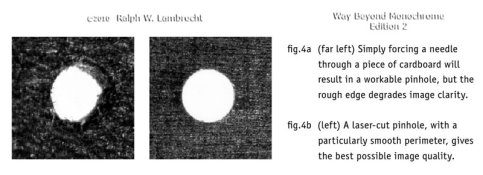My material of choice is pure silver, rolled to .003. I make the hole too big, and with a polished hammer and anvil, I thin and expand the metal with the hole in it. This will make the hole too small, so I repeat this routine over and over, bringing the hole gradually to correct size. There are episodes of dressing, as needed, with a fine jeweler's file. This results in a domed, work hardened square of silver of unknown, but extremely small thickness. I wouldn't blacken with smoke, because of the change in dimension as well as it's susceptibility to rubbing off. Instead, I simply selenium tone the silver, which doesn't affect the dimension. Although it isn't "perfectly" black, the silver, over time, will continue to darken. You know, tarnish.
I am very leery of laser drilled holes, because they will inevitably be tubes. This would be ok, if the material is thin enough. I believe the best holes to be hand finished, and as close to knife edged as possible. It is handy to have had some jewelry experience and facility in working with metal.
About the filter thing, I more or less gave up on it. Eric Renner had suggested I research it and contribute my findings to I guess it must have been the second edition of his book. When I put the filter on - this was gels - every little thing that could get on the filter produced an ugly spot in the negative. With 8x10 film, that was pretty expensive. Of course, doing this out on the desert didn't help. I got to thinking that the solution to the problem would be to fill the pinhole with gel, so that any garbage would be both less likely to be there and couldn't produce the kind of problem I was getting.







